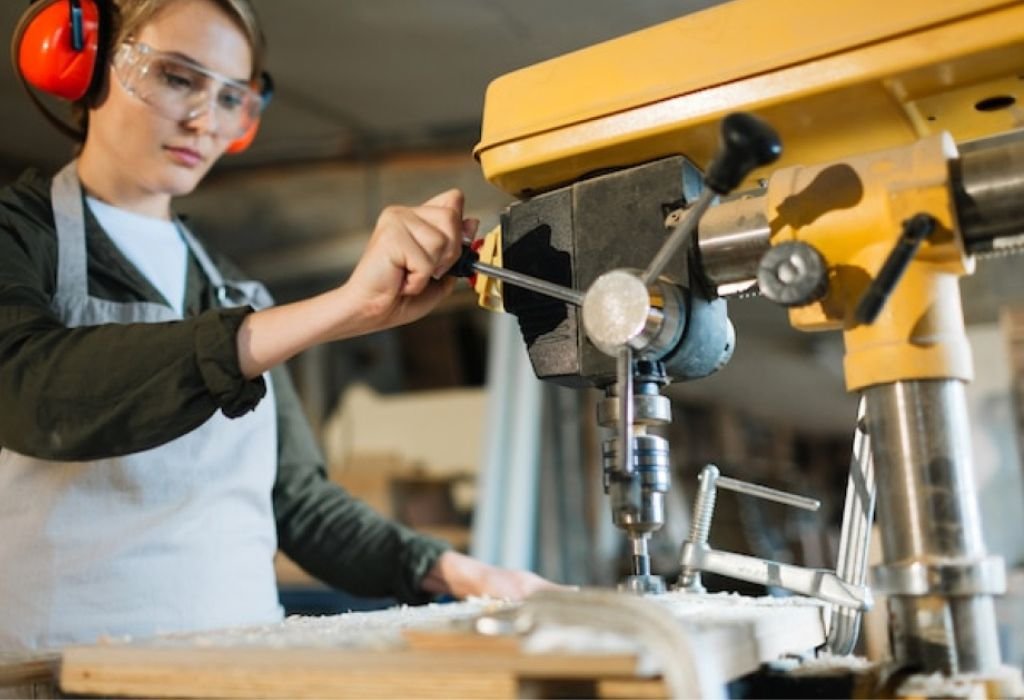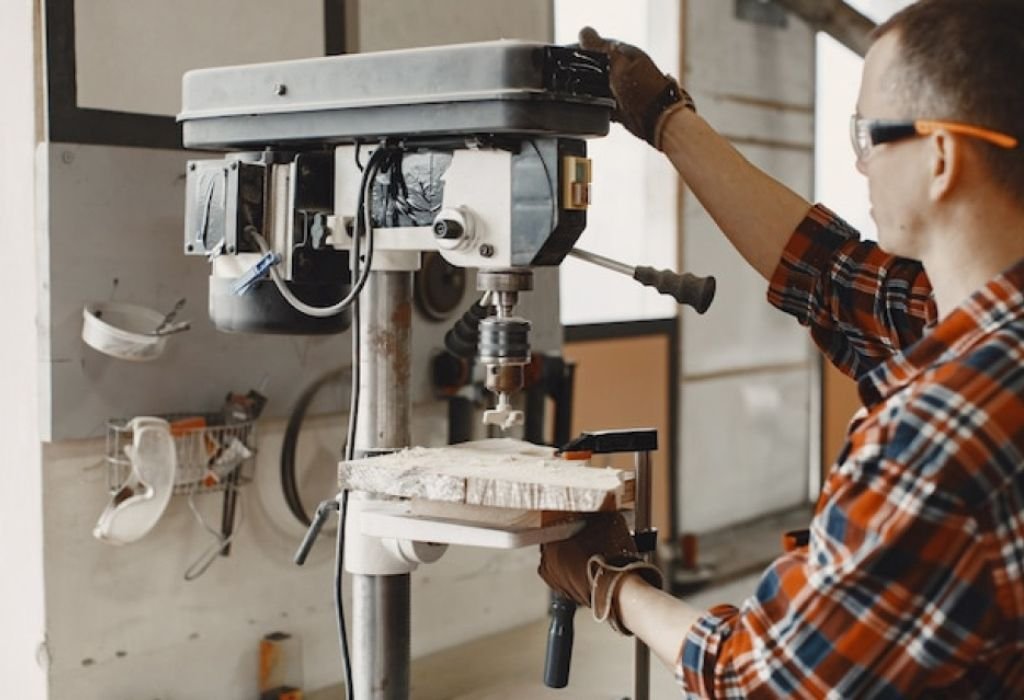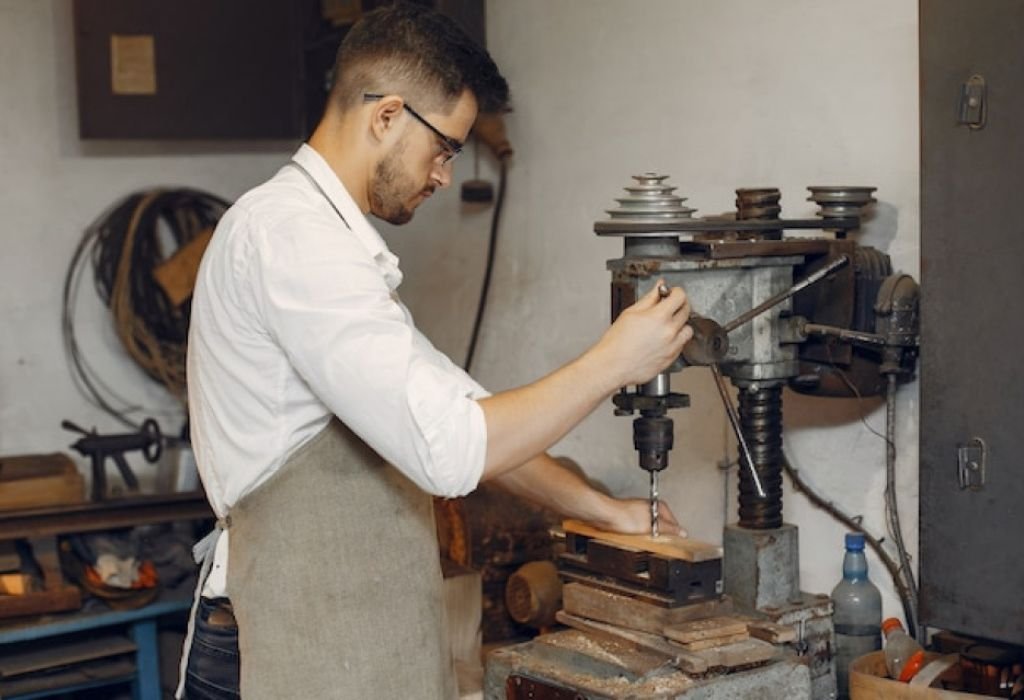Every woodworker or DIY enthusiast reaches that point where they need to shape a round handle, polish a dowel, or create a smooth cylindrical piece — only to realize there’s no lathe in the workshop. The lathe, after all, is a specialized and often expensive tool. So naturally, one question sparks curiosity: can a drill press be used as a lathe?
At first glance, the idea sounds clever. Both machines spin an axis, both involve precision, and both promise controlled rotation. But beneath that similarity lies a world of difference — one built for drilling vertically, the other for shaping laterally. Many hobbyists have attempted to bridge that gap, converting a simple drill press into a makeshift lathe with a few clamps, jigs, and plenty of caution. Some succeed, others damage their bearings, and a few even face safety scares.
According to a survey by Fine Woodworking Magazine, over 35% of small workshop owners experiment with tool conversions to save cost or space — yet most admit that performance rarely matches purpose-built machines. (finewoodworking.com) That statistic alone highlights how common and tempting this question really is.
This guide dives deep into the reality behind the conversion. It explains what makes a lathe different from a drill press, the mechanical stresses involved, and whether the setup can ever truly be safe or practical. You’ll discover the physics, the limitations, and the few cases where it actually works — all grounded in expert insight and real workshop examples.
What Is a Drill Press vs. What Is a Lathe?

A drill press and a lathe may appear similar at first glance — both machines rotate an axis and shape materials with precision. Yet, their mechanical purpose and force direction are fundamentally different, making their roles in a workshop non-interchangeable.
A drill press is designed to apply vertical downward pressure, using a fixed spindle to bore clean, accurate holes. A lathe, on the other hand, holds and spins the workpiece horizontally while a stationary cutting tool removes material from its surface.
When people ask “can a drill press be used as a lathe,” understanding this mechanical difference is the first step. The answer depends on how each machine handles load, rotation, and cutting pressure. The lathe supports the workpiece between centers, distributing force evenly, while the drill press focuses all its stress along a vertical axis.
This difference in design affects everything — from bearing durability to safety and finish quality. That’s why tool engineers always emphasize one rule: use the right machine for the right job.
What is the primary purpose of a drill press?
It’s built for drilling accurate, vertical holes into wood, metal, or plastic with controlled depth and precision.
What does a lathe do differently?
It rotates the workpiece against a stationary cutting tool, allowing for shaping, tapering, threading, and sanding.
Why can’t a drill press handle side pressure like a lathe?
Its bearings are designed for vertical thrust, not lateral force — making side pressure dangerous and damaging.
Does a drill press have a tailstock for support?
No, and that absence is a major limitation when attempting to spin long or heavy workpieces.
Can you modify a drill press to mimic a lathe’s rotation?
Yes, but only for light-duty sanding or polishing tasks — not for true cutting operations that require lateral stability.
Can a Drill Press Be Used as a Lathe? (Theory vs Reality)
In theory, a drill press can mimic some lathe operations, but in practice, the results are limited and risky. The machine’s design prioritizes vertical drilling accuracy, not horizontal side load or material removal through cutting.
The spindle and quill assembly inside a drill press aren’t engineered to handle the sideways force that turning creates. Attempting to use it like a lathe can wear out bearings, cause misalignment, or even eject the workpiece dangerously.
Some makers have built creative DIY attachments to make it work. Popular Mechanics once showcased a vertical lathe setup using a drill press combined with a homemade tool rest. (popularmechanics.com) But even those guides come with clear warnings about safety and precision.
Can wood be turned on a drill press?
Yes, but only small, light pieces using sanding or filing tools instead of cutting blades.
Can metal be shaped this way?
No — the torque and rigidity required exceed what a drill press can safely deliver.
Is it safe to use a drill press as a lathe?
It’s not recommended, as the bearings, quill, and chuck can fail under side pressure.
Can this setup produce a smooth finish?
Sometimes, but only with sanding methods — cutting tools often leave chatter marks.
Does it void the warranty of your drill press?
Yes, most manufacturers void warranties when the machine is used beyond its design purpose.
Limitations, Risks, and Mechanical Challenges
When exploring whether a drill press can be used as a lathe, it’s important to understand what mechanical stresses occur. Drill presses are built for axial loads, meaning the force pushes straight along the spindle. Turning operations, however, create lateral loads that pull sideways on the bearings and quill.
This mismatch can cause damage that’s not visible immediately but shortens the tool’s lifespan. Bearings may loosen, the spindle could wobble, and vibration may increase over time.
Even worse, side pressure can cause the chuck to slip, sending the workpiece flying. Users who’ve attempted the conversion often report tool chatter, bearing noise, or heat buildup within minutes.
Why do drill press bearings fail under side loads?
Because they’re designed for downward thrust, not horizontal stress.
What is spindle deflection?
It’s the bending or wobbling of the drill press spindle under side pressure, leading to poor accuracy.
Can additional supports help?
Supports can reduce vibration but cannot eliminate the fundamental design limitation.
Is tool chatter common in conversions?
Yes — without rigid tool rests and heavy frames, vibrations occur easily.
Can the chuck slip off the taper?
Yes, excessive lateral pressure can cause the chuck to dislodge dangerously.
When Is It Reasonable to Use a Drill Press as a Lathe?

Despite the limitations, there are narrow situations where using a drill press like a lathe can be acceptable. These cases involve light materials, low speeds, and minimal lateral force.
Woodworkers sometimes use this method for short dowels, sanding handles, or shaping cork and softwood. It’s also common for polishing or buffing rather than cutting.
The key is to avoid deep cuts or high speeds. Slow RPM settings help reduce vibration and stress on the bearings. For safety, both ends of the workpiece should be supported — ideally with a makeshift live center or bearing block.
Can you turn short wood pieces safely?
Yes, short dowels or handles are manageable at low speed.
Is sanding better than cutting?
Definitely — sanding applies much less pressure on the spindle.
What speed is ideal?
Start at 200–600 RPM depending on material hardness.
Should both ends be supported?
Yes, using a live center prevents wobble and increases control.
Can you use cutting tools directly?
Avoid sharp tools that dig into the material — use abrasives instead.
How to Convert a Drill Press to a Lathe (DIY Method)
If you decide to experiment cautiously, follow a structured setup to minimize risks. This step-by-step method focuses on small wood projects and prioritizes safety.
Prepare your live center — a rotating point to support the opposite end of the workpiece. You can mount this using a bearing block or tailstock jig secured to the drill press table.
Next, build a tool rest. A simple steel bar clamped horizontally at the right height can help steady your sandpaper or file. Then, align the workpiece between the drill chuck and live center to ensure true rotation.
Once everything is clamped securely, start at the lowest speed. Slowly increase RPM only if there’s no vibration or runout. Always stand to the side, not directly in line with the spinning piece.
What tools are needed?
A live center, bearing support, clamps, and a sturdy tool rest.
How is alignment checked?
Use a dial indicator or mark the piece and rotate manually to confirm minimal wobble.
What speed range is safe?
Generally below 700 RPM for small wood pieces.
What happens if vibration occurs?
Stop immediately, tighten clamps, and rebalance the workpiece.
Should you wear protection?
Yes — always use eye and face shields and stand clear of the spinning axis.
Alternatives and Better Options
Rather than risk damaging your drill press, investing in a purpose-built lathe or combination tool is a smarter choice. A small mini lathe or benchtop lathe costs less than many assume and performs turning tasks safely and efficiently.
A 3-in-1 lathe-mill-drill combo machine can also provide flexibility for small shops. It allows drilling, milling, and turning within one frame, saving both cost and space.
For hobbyists, joining a local makerspace or renting shop time is another option. Many community workshops have shared equipment and safety supervision for beginners.
Is a mini lathe affordable?
Yes — many start around $300–$500 and offer years of reliable use.
What is a 3-in-1 machine?
It’s a hybrid combining milling, drilling, and turning functions in one frame.
Are combination machines effective?
They work well for hobby tasks but not heavy industrial cutting.
Can you outsource turning?
Yes — local machine or woodworking shops often take small turning jobs affordably.
What’s the long-term benefit of a real lathe?
Precision, safety, and versatility for multiple turning tasks.
Drill Press Conversion vs Real Lathe (Comparison)
Understanding the difference in performance helps clarify expectations. Even with modifications, a drill press can only approximate what a real lathe does effortlessly.
A lathe’s spindle bearings are larger, its bed is rigid, and its tool rest is engineered for steady cutting pressure. A drill press, in contrast, flexes under load and quickly loses precision.
| Feature | Drill Press as Lathe | Real Lathe |
| Rigidity / stiffness | Low | High |
| Bearing strength | Weak under side load | Designed for side pressure |
| Precision | Moderate | Excellent |
| Safety margin | Low | High |
| Tool support | Limited | Full carriage and rest |
| Longevity | Short under load | Long-term durability |
Which setup gives better surface finish?
A proper lathe produces smoother, more accurate results.
Which option is safer for long projects?
The lathe’s design and balance make it significantly safer.
Can a drill press match lathe precision?
Not realistically — it’s built for vertical drilling, not shaping.
Does conversion shorten machine life?
Yes, bearings and spindles wear out faster.
Is the conversion worth the effort?
Only if you understand its limits and accept lower-quality results.
Safety Tips and Best Practices

Whenever testing a converted setup, safety must come first. Always inspect the drill press for wear or loosened parts before starting. Ensure the chuck is firmly seated and the workpiece is balanced.
Use the lowest speed setting to reduce vibration. Never push the cutting or sanding tool aggressively. Keep both hands clear of the spinning part and avoid loose clothing or gloves near the machine.
Periodic checks for heat, noise, and vibration can reveal early signs of damage. Stop immediately if you notice wobbling, burning smells, or bearing sounds.
What personal protective equipment should be used?
Safety glasses, face shield, and hearing protection are essential.
Can gloves be worn?
No, they can catch in rotating parts and cause serious injury.
How to detect bearing stress?
Feel for heat and listen for grinding or whining noises.
Should the tool be cleaned after use?
Yes — remove dust and lubricate the quill to extend life.
Can this setup be used frequently?
No, only occasionally for short tasks to avoid long-term wear.
Conclusion
So, can a drill press be used as a lathe? Technically, yes — but only within very narrow limits. The two machines serve distinct mechanical purposes, and substituting one for the other often leads to poor results or even damage.
For quick sanding, light polishing, or shaping soft wood, a careful setup can work temporarily. But for serious turning, precision shaping, or consistent results, investing in a proper lathe is the smarter and safer choice.
Converting a drill press into a lathe is an interesting experiment, not a long-term solution. The better option is to use tools the way they were engineered — ensuring both your safety and the longevity of your machines.

I’m John F. Nicholas, the founder, lead writer, and drill enthusiast behind 101drill.com. With years of hands-on experience in power tools and DIY projects, I created this platform to share practical knowledge, expert tips, and real-world insights to help others master the art of drilling.
